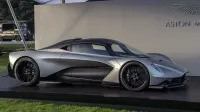Aston Martin developing TT hybrid V6 to replace AMG-sourced V8

We knew that Aston Martin is working on a twin-turbo 3.0-liter V6 hybrid that will fit into the forthcoming mid-engined Valhalla (pictured) and Vanquish sports cars. Car and Driver spoke to Aston Martin boss Andy Palmer, who explained that the engine will effectively replace the Mercedes-AMG-sourced 4.0-liter V8. Palmer explained the rationale by saying, “”Mercedes have made no secret of where their engine technology is moving to, and obviously we don’t foresee four-cylinder engines in our Astons, so we’ve got to make our own journey.”
Autocar reported recently that the next AMG C 63 will be powered by a plug-in hybrid four-cylinder. Aston Martin’s V6-for-V8 substitution means the Vantage, DB11, and DBX will eventually get V6 power, too, although it’s not clear when that will happen. Production of the Valhalla, the model that first brought news of the coming V6, is slated to begin in late 2021.
Palmer all but said the six-cylinder will be more powerful than the eight-cylinder it replaces because “there’s no way our customers are going to expect to step backward” as far as output’s concerned. Regarding the Valhalla, last year when C/D “suggested to an Aston spokesman that the car would need to produce at least as much as the 789-hp McLaren Senna to be regarded as a worthy opponent, he agreed that was a fair assessment.” At the other end, the V8-powered Vantage makes 496 horsepower, leaving plenty of room for graduated tunes among the sports cars. Engineers will need to focus on getting the sound right, Palmer adding, “As long as it feels like a V-8 and sounds majestic, I think it’s a perfectly sensible way to go, and a lot more sensible than an [inline] four would be for us.”
Electric help will take a less revolutionary form than we’re seeing in a number of modern super sports cars. The V6 won’t go plug-in, Palmer wary of the necessary weight gain; Lamborghini’s spoken at length about its trouble finding suitable concepts for the next-gen hybrid powertrains for the Huracán and Aventador that provide an acceptable weight/performance balance. Aston Martin’s plan is apparently to stick with the Valkyrie template, putting an electric motor between the engine and a traditional transmission, instead of using a transmission with an integrated e-motor as seen on coupes like the Acura NSX and Ferrari SF90 Stradale.
Aston Martin intends to go against the current in another way, too, at least for now. Reuters reports fellow English luxury automaker Bentley is already considering Brexit consequences that could include moving more production outside of the UK; “When we look at the current model, where we just bring in built bodies and then do everything else here,” Bentley CEO Adrian Hallmark said, “it may be that we do more outside of the UK and then do the rest here. It may shift the balance, but we’re a long, long way from those discussions.” Palmer, on the other hand, said Aston Martin will build its V6 in Europe, and move V12 production — currently done in Ford’s engine plant in Cologne, Germany — back to the UK.
The $240 million investment led by new Chairman Lance Stroll will help pay for Aston Martin’s car and engine plans. The new mill will be Aston Martin’s first V6-powered road car, and the automaker’s first road-car engine built in the UK since it gave up the 5.3-liter V8 developed by Tadek Marek and used in numerous products from 1968 to 2000.
Related Video:




